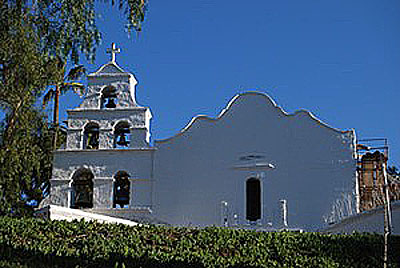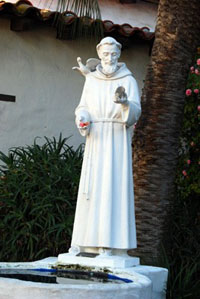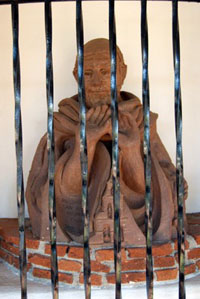
**
By Donald H. Harrison

SAN DIEGO—Visitors will encounter the images of numerous saints at Mission San Diego, but the most prominent in the mission’s own history and traditions are San Jose, San Francisco, and San Diego—known in English as St. Joseph, St. Francis and St. Didacus.
Roman Catholics revere Joseph as the husband of Mary and foster father of Jesus. Because he worked with his hands, either as a carpenter or as a stone mason (the New Testament description in the original Greek could cover either occupation) he is known as the patron saint of workers. The story of Joseph and Mary traveling from Nazareth to Bethlehem, where she gave birth to Jesus, is well known. Joseph is considered also to be a protector of travelers and pregnant women.

In 1769, King Carlos III of Spain authorized an expedition of colonization from New Spain (Mexico) to Alta California (current day California). With Saint Joseph as its patron, the expedition was led by the Franciscan missionary Junipero Serra and the soldier Gaspar de Portola – representing the cross and the sword. There were five arms of the expedition. Two went by land; three in ships named the San Carlos, the San Antonio and the San Jose.
Ironically, the ship bearing the name of St. Joseph never arrived at its destination, having been presumably lost at sea. But belief in his protection of workers and travelers did not abate. In 1770, when lack of supplies prompted Portola to urge Serra to abandon the mission, the padre responded that he would pray for nine days and if nothing happened when that time elapsed, Portola would be free to withdraw, although Serra himself would stay.
The ninth day of Serra’s prayers fell on March 19, the feast day of St. Joseph. As the mission’s chief guide, Janet Bartel tells the story, “On the 19th a ship was seen coming through and of course it went right past. Serra said ‘you said we had to see one. We have.’ Eventually the ship came back. This is also the day that the swallows come back to Capistrano, St. Joseph’s Day. It is so significant to mission history as a whole because if it had not arrived, the military would have abandoned the effort.”
In the Meditation Garden of the mission, the bearded St. Joseph is depicted as barefoot, wearing a white robe, and holding a flower stalk in his right hand. Recently, someone had carefully placed a flower in his left hand, which he appears to be examining.

St. Francis of Assisi founded the Franciscan order of mendicant monks to which Father Serra belonged. Born and baptized as Giovanni de Bernardone approximately in 1182, as a youth he interested himself in games and parties, but forsake this carefree life after repeated visions and after renouncing his father’s mercantile way of life took vows of poverty. One of his visions at St. Damian’s Church near his home in Assisi was of an icon of Jesus Christ telling him to repair His house, which was in disrepair. Starting with St. Damian’s, rebuilding churches became a passion of St. Francis.
Padres who built and oversaw Mission San Diego similarly found themselves constantly rebuilding or repairing their church. After establishing it in 1769 at the Presidio, the mission was moved in 1774 to its current location. However, it was burned to the ground by Native Americans in 1775, and had to be rebuilt several times thereafter owing to natural catastrophes and weathering.
Some of the most popular stories about St. Francis concerns his love for animals. He and his followers would go from town to town, their preaching drawing larger and larger crowds. Once, during his travels, he stopped on his way to preach to birds, explaining to them that God provided them food, trees in which to nest and plumage, for which they were expected to do nothing in return except to love God.
Another story tells of a town that lived in fear of a wolf that killed not only their dogs and livestock but sometimes fed upon human residents. St. Francis went into the mountains and spoke to the wolf, which immediately lay at his feet. He told the wolf that he had done evil, but if it would come with him to the town, he would make matters right. St. Francis told the townspeople the wolf only had done what it had because it was hungry; if they would put out food for the wolf, he would never bother the townspeople again.
One of the annual events at Mission San Diego is the Blessing of the Animals, which in some places occurs on Oct. 4 on St. Francis’ feast day, but at Mission San Diego is timed to coincide with the Sunday closest to the mission’s founding date of July 16.
St. Francis is given credit as the first person to devise a crèche to help people picture the scene in the manger attending the birth of Jesus. In his displays, St. Francis would actually use live animals. During the Christmas season, a crèche is set up at the mission.
As leader of the Franciscans, St. Francis visited Egypt during the time Crusaders were in nearby Palestine. He was brought before the Sultan, whom he challenged to a walk through fire to see whether the sultan’s Muslim faith or St. Francis’ Christian faith was more acceptable to God. The sultan declined, but according to Roman Catholic accounts, was so impressed that he asked St. Francis to pray to God so that the true religion would be revealed to the sultan. The favorable impression of St. Francis lingered through the centuries; after Muslims reasserted their control over Jerusalem, they agreed to permit the Franciscans to serve as Guardians of the Christian shrines.
St. Francis is depicted in the mission’s Meditation Garden by a statue in which he wears sandals and a tunic tied around the waist by a rope. One bird is in his left hand, another bird is on his right shoulder. In his upturned right hand, someone had placed a flower.

A third important saint is the one for whom the mission is named, San Diego de Alcala. It was not Serra, but the explorer Sebastian Vizcaino who chose the name for the area in 1602. Sixty years earlier in 1542, the explorer Juan Rodriguez Cabrillo had claimed the area for Spain and had named it San Miguel, after the archangel Michael. Vizcaino said he did not recognize the bay as the one Cabrillo had named, and thus gave it the new name of San Diego.
Of San Diego, or Saint Didacus, the story is told that he was born in San Nicholas del Puerto, in the Spanish province of Andalusia. He became a member of the Franciscan Order and worked and preached in the Canary Islands. When he was 50 years old, he visited Rome and took over an infirmary at Ara Coeli, where several sick friars were said to have been miraculously restored to health under his care. Subsequently he returned to Spain, to live out his life in Alcala, a university town.
Wikipedia relates the story that when Didacus died in 1463, rather than the foul odor of decay, his body emitted a sweet smell and did not decompose. Two members of Spain’s royal family subsequently credited the body of Didacus with restoring their health. Henry IV of Castile (1425-1474) after injuring his arm in a fall from a horse had Didacus’ body brought to him. He kissed the body and placed the hand of Didacus on his arm. The pain went away and his strength was restored. Approximately a century later, in 1562, Prince Don Carlos, son of King Philip II of Spain, after a night of revelry, fell down a flight of stairs and was rendered unconscious. Partially paralyzed and later growing blind, he asked that the body of Didacus be brought to his bedside. Touching it he fell into a deep sleep. On awakening six hours, he told of a dream in which Didacus told him he would recover . He did.
Today, the campus where the Catholic-run University of San Diego was built is known as Alcala Park, and Alcala, Spain, is a Sister City of San Diego’s. At the mission, San Diego is one of nine saints whose sculpted images have been placed in wall niches along the exterior colonnade of the mission. Each of the images represents a mission founded under the administration of Junipero Serra, with Mission San Diego the first. The others in order of their founding are San Carlos Boromeo, San Antonio de Padua, San Gabriel, San Luis Obispo, San Francisco, San Juan Capistrano, Santa Clara and San Buenaventura. There also is a centuries-old painting of St. Didacus on the church’s altar.
*
Harrison is editor of San Diego Jewish World. This article previously appeared on examiner.com